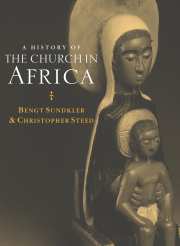Book contents
- Frontmatter
- Contents
- List of maps
- Acknowledgements
- List of abbreviations
- Introduction
- PART I THE FIRST FOURTEEN HUNDRED YEARS
- PART II THE MIDDLE AGES 1415 – 1787
- PART III THE LONG NINETEENTH CENTURY 1787 – 1919
- 3 Overview To The Nineteenth Century
- 4 North and North-Eastern Africa
- 5 Western Africa
- 6 West-Central Africa
- 7 Southern Africa
- 8 South-Central Africa and the Indian Ocean
- 9 East Africa
- 10 East-Central Africa
- PART IV THE COLONIAL EXPERIENCE 1920 – 1959
- PART V INDEPENDENT AFRICA 1960 – 92
- Notes
- Bibliography
- Name index
- Subject index
5 - Western Africa
from PART III - THE LONG NINETEENTH CENTURY 1787 – 1919
Published online by Cambridge University Press: 16 September 2009
- Frontmatter
- Contents
- List of maps
- Acknowledgements
- List of abbreviations
- Introduction
- PART I THE FIRST FOURTEEN HUNDRED YEARS
- PART II THE MIDDLE AGES 1415 – 1787
- PART III THE LONG NINETEENTH CENTURY 1787 – 1919
- 3 Overview To The Nineteenth Century
- 4 North and North-Eastern Africa
- 5 Western Africa
- 6 West-Central Africa
- 7 Southern Africa
- 8 South-Central Africa and the Indian Ocean
- 9 East Africa
- 10 East-Central Africa
- PART IV THE COLONIAL EXPERIENCE 1920 – 1959
- PART V INDEPENDENT AFRICA 1960 – 92
- Notes
- Bibliography
- Name index
- Subject index
Summary
SENEGAMBIA
Ma-Ba, the Grand Marabout of Senegal about 1840, was determined to ‘impose Islam on all the infidels in the kingdoms of Senegambia’. In order to achieve his goal he was prepared to use various means, even supporting the claims of Lat-Dyor, the syncretistic Damel (King) of Cayor, the most important kingdom between Dakar and St Louis, the European forts and outposts of the coasts. In comparison with the pressures of Muslim power, the Catholic presence appeared extremely limited. The French missionaries spoke of Senegal or Senegambia but, in fact, they were hardly concerned with much more than the two island towns of St Louis and Gorée, with some 6,000 inhabitants altogether, of whom three-quarters were captives and slaves.
The Catholic faith in these parts of West Africa had to a large measure been integrated with the French colonial presence. After the vicissitudes of revolution and wars, the French were at last able to repossess Gorée in 1817. Wolof and Oualo chiefs were willing to consider French trade, and Colonel Julien Schmaltz the first French governor, built a French port at Dagans. Problems associated with European colonial personnel made the French presence ineffective. In the years 1843–48, no less than eight governors succeeded one another at Gorée! The colonial chaplains, legal representatives of the European' religion, fared little better. Some of them were complacent, playing the supposedly sophisticated role of the worldly chaplain.
- Type
- Chapter
- Information
- A History of the Church in Africa , pp. 169 - 277Publisher: Cambridge University PressPrint publication year: 2000



